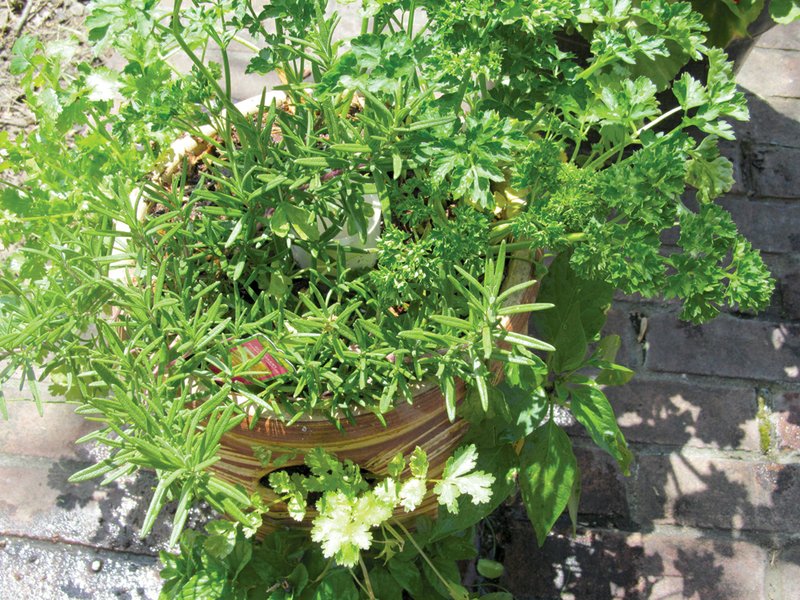The use of herbs in cooking goes back thousands of years, so it seems that a practice that has weathered this eternal test of time would be simple and streamlined. Not so fast! The varieties are abundant, yet the availability of fresh, dried or preserved products could confuse even the most accomplished cook. Courage and confidence are required. The reward of using these delicious complements to your dishes is a blue-ribbon satisfaction from family and friends.
Farmer’s markets are opening all over the state, offering the early treats from the garden. Much of the springtime bounty is young and tender offerings; spindly asparagus, bite-sized creamy new potatoes with fragile skin begging to be crisped in a sprinkling of fragrant olive oil, zesty scallions and sweet onions, vibrant early peas and maybe the first few delicate strawberries, ruby-like and just as precious. All are offered alongside the easy-to-grow herbs that add interest and complex flavors.
Green thumb or not, herbs have grown wild for centuries and many varieties can be easily grown along with the regular pansies or impatiens in your garden. Most require only full to partial sun, regular water and regular harvesting. If the plant’s abundance exceeds your need, there are methods of drying or freezing that preserve your bounty.
An almost fail-safe beginning is basil. A major component in cooling summer Caprese Salad, basil will proliferate in the garden, give beautiful fullness and add freshness to a variety of cuisines including most satisfying pastas, crowd-pleasing pizzas and refreshing salads.
Grow rosemary in a hot, dry, sunny location. Rosemary is evergreen in most of the Arkansas growing area. Rosemary grows well in containers, and you can bring it indoors over winter in cold climates.
Chives are the mildest form of scallions and fit into the family with onions, leeks and garlic, whose green sprouts called ramps (leeks) and spates (garlic) are highly valued on restaurant menus because they are limited in availability and very mild.
Dill, garlic, oregano, thyme, mint, cilantro and sage are other simple herbs that can be integrated into the garden or planted in containers. Salsas and sauces beg for their fragrant, herbaceous accent. Harvest often to encourage their naturally prolific growth. Some herbs, like mint, are aggressive and will overtake beds if not maintained.
BASIL PESTO
This simple recpie for basil and garlic has endless uses but can easily accent fish, chicken and appetizers.
Ingredients:
2 cups packed fresh basil leaves
2 cloves garlic
1/4 cup pine nuts
2/3 cup extra-virgin olive oil, divided
Kosher salt, to taste
Freshly ground black pepper, to taste
1/2 cup Pecorino/Romano or Parmesan cheese, freshly grated
Directions:
Combine the basil, garlic and pine nuts in a food processor and pulse until coarsely chopped. Add 1/2 cup of the oil and process until fully incorporated and smooth. Season with salt and pepper.
HERB CRUSTED PORK LOIN
Adapted from Paula Deen
Ingredients:
1 boneless pork loin, leave fat on
1 tablespoon Kosher salt
3 tablespoons olive oil
4 cloves garlic, minced
1 teaspoon dried rosemary or 2 teaspoons minced fresh rosemary
1 teaspoon dried basil or 2 teaspoons fresh basil leaves
1 teaspoon dried thyme or 2 teaspoons minced fresh thyme leaves
Directions:
Preheat oven to 450 degrees.
Place the pork loin on a rack in a roasting pan.
Combine the remaining ingredients in a small bowl. With your fingers, massage the mixture onto the pork loin, covering all of the meat and fat.
Roast the pork for 30 minutes, then reduce the heat to 425 degrees and roast for an additional hour. When the internal temperature reaches 140 degrees on a meat thermometer, remove from the oven. Allow the roast to rest, tented in foil, for about 20 minutes before carving. It will continue to cook while it rests.
BROILED SALMON WITH HERB GLAZE
Ingredients:
2 garlic cloves
3/4 teaspoon fresh thyme leaves, finely chopped
3/4 teaspoon fresh rosemary leaves, finely chopped
1 tablespoon dry white wine
1 tablespoon extra-virgin olive oil
2 tablespoons whole-grain mustard
2 tablespoons Dijon mustard
4 salmon fillets, 6 to 8 ounces
Kosher salt and freshly ground black pepper to taste
4 lemon wedges, for serving
Directions:
In a food processor, combine garlic, herbs, wine, oil and mustards. Process the sauce combined, about 30 seconds. Set aside.
Preheat the broiler. Cover a heavy baking sheet with foil and spray with non-stick spray or cover with a light coating of oil. Arrange the salmon fillets on the baking sheet, sprinkle with S & P, broil for two minutes. Spoon the mustard sauce over the fillets. Continue broiling until the fillets are just cooked through and lightly browned, about 5 minutes longer.
Serve with lemon wedges.
